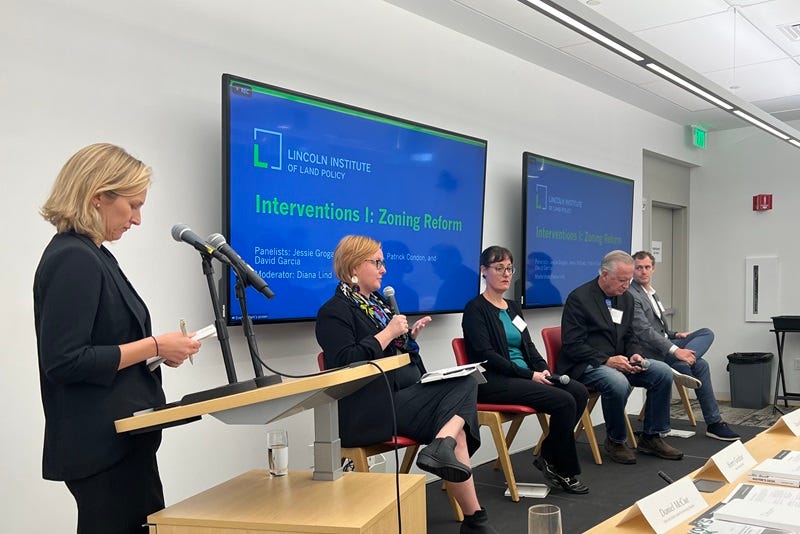You may have heard – YIMBYism won big in 2023.
A piece by Matt Yglesias and a Bloomberg Citylab article detailed last year’s YIMBY successes: the 56 California bills passed to address housing, Montana’s “miracle” of ADU reform, Vermont’s reduced minimum lot sizes, and reforms in a handful of other states from Arkansas to Wisconsin. When Austin announced the end of its parking minimums as a way to address its affordability crisis, YIMBYism was the language used to talk about housing in cities.
But at a recent conference held by the Lincoln Institute of Land Policy, where I moderated a conversation about statewide zoning reforms, the measurable, positive impact of all these YIMBY reforms seemed a lot less clear.
Jenny Schuetz, who recently coauthored a Lincoln Institute Policy Download on implementing state housing reforms, said it’s too early to tell if these reforms are actually producing more housing or more affordability. And David Garcia of the Terner Center noted that many of the bills in California are being re-litigated, making the local implementation of statewide reforms less certain. Patrick Condon of the University of British Columbia served as the panel’s skeptic, asking: Does density actually lower housing costs? He provided evidence it does not, at least in Vancouver:
“We have doubled the number of people per square kilometer in the city since 1970; there is no other center city that I’ve been able to find in North America that’s come even remotely close to the addition of new supply,” Condon said. “If adding supply was going to reduce prices, Vancouver should have the cheapest housing in North America. It now has the most expensive housing in North America.”
While YIMBYism has flaws (the above photo perfectly illustrates its lack of engagement with communities of color, as just one example), we can agree that it’s impressive how the YIMBY movement has managed to bridge the chasm between liberal and conservative politics to achieve its goals and further its agenda.
The YIMBYism mantra of less regulated development appeals to free-market thinkers, the simple math of more supply to meet demand appeals to pragmatic centrists, and the objective of creating more walkable urbanism appeals to liberals. The YIMBY movement has tapped into a broad coalition from real estate developers to transportation advocates to AARP, becoming an unstoppable force in housing.
But while we should cheer these apparent YIMBY wins, there’s a problem that YIMBYism simply can’t solve: a growing portion of the American public needs subsidized housing. No market-rate math is going to work for the 37 million Americans living in poverty and at risk of homelessness.
Most of the subsidized housing in the U.S. is accessed through tenant-based vouchers, commonly known as Section 8 and officially called Housing Choice Vouchers, issued by the U.S. Department of Housing and Urban Development (HUD). Frustratingly, there are not as many Housing Choice Vouchers as households that need them, but yet hundreds of thousands of Section 8 vouchers go unused each year. Landlords frequently (and illegally) discriminate against vouchers as a source of income for housing. Advocates, such as Matthew Desmond, who have pushed for more housing vouchers, even getting an expansion of housing vouchers to become a Biden campaign promise, have been thwarted because there’s recognition that more vouchers won’t solve this fundamental problem with landlords.
Why We Should Be Talking About Project-Based Vouchers
But there is another kind of voucher that HUD provides — project-based vouchers — that we should be talking much more about. The Center for Budget and Public Policy has this useful chart explaining the differences between the two kinds of vouchers. But simply put: project-based vouchers are tied to a housing development, rather than a tenant.
While there are more than 2 million households using Housing Choice Vouchers, there’s only about 260,000 served through project-based vouchers.
But if we had hundreds of thousands of more project-based vouchers, we could open up a whole new way to quickly and inexpensively build the subsidized housing this country desperately needs. And that potential for faster, less expensive development could engage the real estate developer community needed to support advocacy for voucher reform.
To explain why, I need to tell you about how we build most of the subsidized housing in this country today through the Low Income Housing Tax Credit (LIHTC) program.
LIHTC (pronounced “li-tech”) works like so: the IRS makes tax credits available to states, which then award those credits to developers with eligible projects. Developers then sell those credits to investors who invest the equity from the sale of the credits to finance the construction of the project. LIHTC deals are extremely financially complex, and because of that complexity, many expensive lawyers and accountants are required to finalize these deals. There are a number of other elements that add cost and time, such as the regulations that are triggered when these projects also need money from HUD to fill in their financing gaps. This is why you hear about low-income housing costing $1 million per unit in California and why a LIHTC project can easily take a decade from credits issued to tenants living in units. In a time of such scarcity of subsidized housing, LIHTC is unacceptably slow and expensive.
So why do we still do it? These tax credits are often the only way to get the financing needed to build affordable housing and local entities can rarely find a better way to invest the funds they get from HUD than in these projects. And those lawyers and accountants have formed an imposing lobbying group that protects LIHTC and ensures that $9 billion in tax credits are issued each year.
Which brings us back to how YIMBYism became so successful: it’s got the capitalists on its side. Yes, well-intentioned environmentalists, housers, politicians, and others have made YIMBYism successful, too; but YIMBYism would not have the cross-over appeal without the buy-in, money, and lobbying of the developer community.
Meanwhile arguments for more housing vouchers have largely been based on morals. We should be providing more vouchers for poor people because that is the morally right thing to do. While this is true, apparently many members of Congress don’t care, and simply trying to convince the government to spend more money on the poor has been a losing battle for the past half century.
Voucher advocates need to emulate or join with the YIMBY movement and recognize there is a business case for providing more project-based vouchers.
Project-based vouchers are like gold for developers: they offer federally guaranteed rent. It’s like the difference between building a house on spec, and building a house for a committed buyer. Project-based vouchers completely change the math for affordable housing development. Because the rent is federally guaranteed, now the development has zero risk to a private lender. Loans could then be secured quickly and at lower interest rates. Unlike a LIHTC deal in which multiple sources of capital have to be cobbled together — tax credits, loans, grants, etc. — project-based vouchers make the deal straightforward and reduce the need for developers to hunt for additional subsidy. And because the vouchers are tied to the project, there could be no source-of-income discrimination from the landlord’s side — meaning none of these vouchers would go unused.
Yes, project-based vouchers still require a decent amount of red tape, including housing quality standards inspections. But advocating for the expansion of project-based vouchers could, like YIMBYism, have cross-over appeal for liberals and conservatives. For liberals who envy Europe’s social housing, project-based vouchers would be the way to get that abundant housing built in cities. For conservatives who want to create jobs and support private industry, project-based vouchers would enable more development, construction, and private lending. For those who believe need to lift more people out of poverty, more project-based vouchers would help move us beyond the stale dilemmas around tenant-based vouchers and LIHTC.
The only problem is that there’s not enough of these vouchers. And this is where coalition building and the YIMBY movement come in.
YIMBYism may have won 2023, but if it doesn’t show that it can meaningfully address the affordability crisis, it will eventually lose adherents. YIMBYism could take on the cause of project-based vouchers as a more pragmatic, fast-paced approach to building subsidized housing. Indeed, it could be a way to make peace with the PHIMBY (public housing in my backyard) faction. Project-based vouchers are a way to encourage subsidized housing, but with a kind of market-driven approach that is less encumbered by public housing authorities and government stewardship of the housing.
It’s an obvious pivot for YIMBYism. Otherwise, what will YIMBYs be fighting for in 10 years: dense cities full of luxury housing that no one can afford to live in?
Liked this piece? Please share it!











> “We have doubled the number of people per square kilometer in the city since 1970; there is no other center city that I’ve been able to find in North America that’s come even remotely close to the addition of new supply,” Condon said. “If adding supply was going to reduce prices, Vancouver should have the cheapest housing in North America. It now has the most expensive housing in North America.”
This is a really weak argument that density doesn’t decrease housing costs. Vancouver has way more than doubled in desirability since 1970, and it has 3x the population it had in 1970
The reality is that if Vancouver hadn’t added the housing it has added it would have even higher costs … and if it were able to double or even triple its density again it would see cost decreases.
This is such a timely reminder for me... just last fall, I heard Alan Mallach speak at a conference where he gently chastised any of us in the audience who thinks that increasing supply alone with solve the housing crisis... a position I've admittedly leaned on in the past. Despite being in housing for my entire career, I'm still amazed at the huge industry (and accompanying COST) that has developed around LIHTC deals, without meaningfully solving the housing crisis.